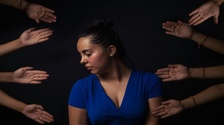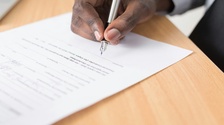Today, I'm going to teach you better ways to greet people in English.
Your textbooks and teachers have probably taught you the weird foreigner ways to greet people in English.
Look at the following ways to greet people:
“How are you today?”
“I'm fine, thank you, and you?”
“How do you do?”
Now… forget them.
You can use them, but I suggest that you only use them in formal situations.
Business meetings = okay.
Talking with friends/people you've know for a while = not okay.
I'm going to teach you English greetings that are informal. You can use them with friends, family, acquaintances, and even people you don't know too well.
Using informal speech in English is not rude. It is actually the opposite because you use it with friends. So, a good way to make English friends is to use informal speech and smile.
Here are the native greetings you must know:
“How's it going?”
This is asking the same question as “How are you?”. Respond by saying: “Yeah, it's good, you?”
Notice that you don't say “I'm good”. You say “It's good.” This is because it is referring to the situation. It--the situation--is good.
You can also respond: “Not bad.” Or you can repeat this phrase: “Not bad, not bad.”
Remember: not bad = good.
It sounds weird but trust me, if someone says that something is “not bad”, they are being positive.
British English speakers often say that they are well by saying that things are not bad.
Americans are much more likely to respond to “How's it going?” or “How are you?” with the word “awesome”. For Americans, everything is awesome. They are the complete opposite of their British brothers. They could be having the worst day ever, but ask them how they are and they will say they are awesome.
I will always remember a conversation I had with an American woman in Arizona. I asked her how she was and she replied, “Awesome!” After a lot of conversation, I discovered that she had had her purse stolen that day, had just had a fight with her best friend, and her mum was in the hospital. But still, she was awesome.
Quick tip: if you are in Britain, or talking with British people, and you have had a bad day, let them know. Here are some appropriate responses to the question “How's it going?” if you've had a bad day and you are British:
- “Pretty shit, to be honest.”
- “Crap.”
- “I'm having such a bad day.”
British people love to moan and talk about their problems. Tell a British person you're having a shitty day and you've made a friend. They will likely respond by telling you how shitty their day has been too.
“How's it going?” can be used in different situations. It is not just a greeting. For example, if your friend is doing some work, you could ask them, “How's it going?” If they say “It's good,” they are saying the work is good or going well. They could say “Not so good” or “It's not good” if the work is going badly.
“What's up?” and “Sup?”
“What's up?” is American-influenced, but young British people use it a lot. You can turn the phrase into one word: “Sup?”
You can use more than one greeting in a sentence:
1: “What's up, man, how's it going?”
2: “Yeah, it's good, thanks, what's up with you?”
Here is an example conversation between two friends who haven't seen each other for a long time:
Person 1: “What's up, man, long time no see.”
Person 2: “How's it going, my friend?’
Person 1: “Yeah, it's good, you?”
Person 2: “Not bad, not bad. You okay?”
Let's look at the different meanings of “What's up?” and the correct responses.
- It's a greeting. “What's up?” can mean “hello” in an informal way. The best response is to also say “What's up?” in return.
- It also means, “How are you?” But the speaker doesn't usually expect to know exactly how you are. The best response is “Not much.” E.g:
- Them: “What's up?”
- You: “Not much. You?”
- It can mean, “What's wrong?” If you look really sad or ill or depressed, someone might ask you “What's up?” You will know that it means this if the person asks you in a concerned tone of voice. You can tell them what's wrong. Just say, “I'm not feeling well,” or “I've had some bad news,” or whatever the problem is. If you don't want to talk about it, just say “Nothing,” or “No big deal,” or “Don't worry.”
- It can also mean, “What's new?” or “What's happened in your life recently?” You can respond by saying what has happened. For example: “I got a new job,” or “I'm tired at the moment.” But most people don't respond in this way.
Bonus response: A lot of English speakers absolutely hate the phrase “What's up?” If you don't like the phrase and somebody asks you “What's up?”, you can say something stupid like this:
Them: “What's up?”
You: “The sky.”
Them: “What's up?”
You: “Planes.”
Them: “What's up?”
You: “The roof.”
“What's the craic?”
This is a variation on “What's up?” that translates to “What's been happening?” The phrase comes from Ireland, but it is now used in England and America. If you want to sound more authentic, put the word like at the end of the phrase: “What's the craic, like?”
An appropriate response would be, “Not much, what's the craic with you?”
“How's it hanging?”
Another variation on “How's it going?” This phrase is American slang.
“Alright?”
This phrase is used a lot in Northern England. It translates to “Hello.” The appropriate response to “Alright?” is “Alright.” Try raising your eyebrows a little and nodding your head when you say it.
“What have you been up to?”
“What ya been up to?” and “What've ya been up to?” are also used and mean the same thing. Appropriate responses are anything that explains what you have done, e.g.:
“Well, yesterday I went to the cinema with my friends, and I've been studying a lot. What about you?”
You don't have to say exactly what you've been up to. Instead, you can just say “This and that,” or “Ah, you know, same old, same old,” or “Bits and bobs.”
Here's an example conversation between two friends:
1: “Alright? How's it going?”
2: “Alright. Yeah, not bad. What ya been up to?”
1: “Ah, you know, this and that. Same old, same old. You?”
2: “Yeah, not much. Lots of school work, bits and bobs.”
During your interactions with English speakers, you will want to add in some terms of affection. These are commonplace and you will hear them a lot. Feel free to use them as much as you want. You should definitely use them with anyone who uses them with you.
“Mate”
This word is primarily British and Australian. Americans know what this word means but if you use it with them you will sound very British or Australian. In Britain, males will use it with all other males, whether they know them well or not.
A typical greeting to any male in Britain is “Alright, mate?” This is obvious in taxis. Taxi drivers will greet their male passengers in this way. “Mate” literally means “friend,” but you don't have to use it just with your friends.
“Man”
This is American but it is used a lot in Britain now. It is used by the younger generation. Use it the same way you use “mate”.
“Dude”
Again, an American word, but widely used all over the English-speaking world.
“Darling”
I don't use this, but you may hear it in some areas of the English-speaking world. You might hear older women will use it with younger men and older men will use it with younger women.
“Geezer”
This is British, particularly London British. It means “mate”. Actually, literally translated, it means “old man”, but don't worry about that. You will hear this used by working class men to address other men. If you use it yourself, you will sound like you come from London.
“Catch ya later”
This is something you can say instead of “goodbye” at the end of speaking with a friend. It basically means ‘see you soon’ and can be used like this:
“Alright, mate. Good seeing ya. Catch ya later. Take care, yeah.”
Another way to say goodbye is “Cheerio.” It's quite old-fashioned, but sounds friendly and fun!
I hope this has helped and you found it interesting! Next time you need to greet an English speaker, try using any of these words. Let me know in the comments about any interesting ways to greet people in your language!
Cheerio!
If you enjoyed this article, you can learn more ways to sound native in my book, 3 Weeks to Better English: Speak with Slang, Sound like a Native.







